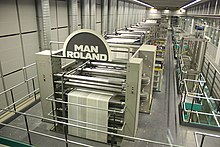
Printing is a process for mass reproducing text and images using a master form or template. The earliest non-paper products involving printing include cylinder seals and objects such as the Cyrus Cylinder and the Cylinders of Nabonidus. The earliest known form of printing as applied to paper was woodblock printing, which appeared in China before 220 AD for cloth printing. However, it would not be applied to paper until the seventh century. Later developments in printing technology include the movable type invented by Bi Sheng around 1040 AD and the printing press invented by Johannes Gutenberg in the 15th century. The technology of printing played a key role in the development of the Renaissance and the Scientific Revolution and laid the material basis for the modern knowledge-based economy and the spread of learning to the masses.
The Mergenthaler Linotype Company is a corporation founded in the United States in 1886 to market the Linotype machine, a system to cast metal type in lines (linecaster) invented by Ottmar Mergenthaler. It became the world's leading manufacturer of book and newspaper typesetting equipment; outside North America, its only serious challenger for book typesetting was the Anglo-American Monotype Corporation.

MAN SE was a manufacturing and engineering company based in Munich, Germany. Its primary output was commercial vehicles and diesel engines through its MAN Truck & Bus and MAN Latin America divisions, and participation in the manufacturer Sinotruk.

A rotary printing press is a printing press in which the images to be printed are curved around a cylinder. Printing can be done on various substrates, including paper, cardboard, and plastic. Substrates can be sheet feed or unwound on a continuous roll through the press to be printed and further modified if required. Printing presses that use continuous rolls are sometimes referred to as "web presses".
Job Definition Format (JDF) is a technical standard being developed by the graphic arts industry to facilitate cross-vendor workflow implementations of the application domain. It is an XML format about job ticket, message description, and message interchange. JDF is managed by CIP4, the International Cooperation for the Integration of Processes in Prepress, Press and Postpress Organization. JDF was initiated by Adobe Systems, Agfa, Heidelberg and MAN Roland in 1999 but handed over to CIP3 at Drupa 2000. CIP3 then renamed itself CIP4.

Offset printing is a common printing technique in which the inked image is transferred from a plate to a rubber blanket and then to the printing surface. When used in combination with the lithographic process, which is based on the repulsion of oil and water, the offset technique employs a flat (planographic) image carrier. Ink rollers transfer ink to the image areas of the image carrier, while a water roller applies a water-based film to the non-image areas.

Rotogravure is a type of intaglio printing process, which involves engraving the image onto an image carrier. In gravure printing, the image is engraved onto a cylinder because, like offset printing and flexography, it uses a rotary printing press.
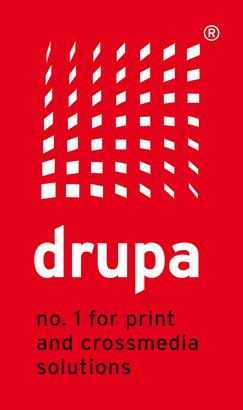
Drupa is the largest printing equipment exhibition in the world, held every four years by Messe Düsseldorf in Düsseldorf, Germany. The word drupa is a portmanteau of the German words Druck und Papier.
KUKA is a German manufacturer of industrial robots and factory automation systems owned by Chinese appliance manufacturer Midea Group.

HP Indigo Division is a division of HP Inc.'s Graphic Solutions Business. It was founded in 1977 in Israel and acquired by Hewlett-Packard in 2001. HP Indigo develops, manufactures and markets digital printing solutions, including printing presses, proprietary consumables/supplies and workflow solutions. HP Indigo has offices around the world, with headquarters in Ness Ziona, Israel.

The Renk GmbH is a German global manufacturer of transmissions, engines, hybrid drive systems, vehicle suspension systems, plain bearings, couplings, and testing systems. The company builds special gearboxes for tanks, frigates, icebreakers, and industry and is a leading supplier of running gear and damping systems for tracked and wheeled military vehicles. Renk is headquartered in Augsburg and in addition to its headquarters, also manufactures in Rheine, Hanover, Winterthur, Bath, and Sterling Heights.
Prinergy is a prepress workflow system created by Creo in 1999 and maintained and sold through Kodak. It is a client/server system that integrates PDF creation, job proofing, imposition, and a raster image processor (RIP) into one unified workflow.
Muller Martini, based in Switzerland, manufactures paper inserting systems, mail room delivery systems, and other printing-related equipment. Manufacturing facilities are located in Switzerland, Germany, and the United States.

Heidelberger Druckmaschinen AG is a German precision mechanical engineering company with registered offices in Heidelberg (Baden-Württemberg) and headquarters in Wiesloch/Walldorf (Baden-Württemberg). The company offers product and services along the entire process and value chain for printing products and is the largest global manufacturer of offset printing presses. Sheet-fed offset printing is used predominantly for high-quality, multi-colour products, such as catalogues, calendars, posters, and labels. Heidelberg produces equipment for prepress, press and postpress.
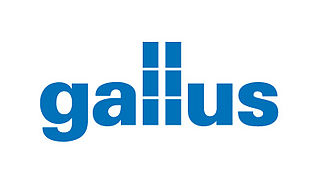
Gallus Holding AG, based in St. Gallen, Switzerland, is an international manufacturer of label printing and folding carton presses. Since 2014, Gallus is a complete subsidiary of Heidelberger Druckmaschinen AG.
The Stibo Software Group was founded in 1794 by Niels Lund as a printing company. Today, Stibo Software Group provides information management and print technology software for business operations. It is headquartered in Aarhus, Denmark. They operate internationally through their subsidiaries in Europe, North America and Asia. The company is wholly owned by The Stibo-Foundation.
Print process simulation uses interactive simulation software to reproduce the operating conditions of complex multi-colour printing presses that often cost several million dollars. Simulators are available for different printing process technologies, includes their consumables and where pertinent, in-line packaging operations.
The newspaper production process begins with gathering news stories, articles, opinions, advertorials and advertisements to printing and folding of the hard copy. Usually, the news items are printed onto newsprint. The whole production process can be divided into four parts: Content gathering, Pre-press, Press and Post-press. The term production process should not be confused with manufacture as Production process is the stage at which many taxes are levied and collected in almost all countries. Manufacture is the stage at which the product becomes marketable and therefore the term also includes the stages of packaging and packing.
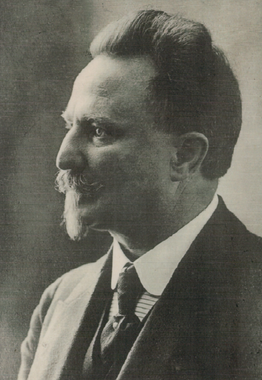
Robert Zahn was a German engineer and industrialist. Zahn started designing embroidery machines. As the director of the Vogtländische Maschinenfabrik (VOMAG) at a later stage, he played a major role in the technical perfection of the machines being produced there. The Plauen firm became one of the leading public limited companies in the engineering sector in Germany under his leadership.
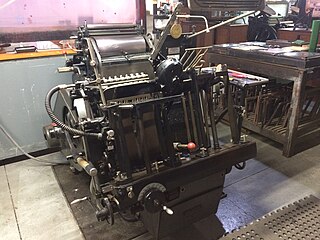
The Original Heidelberg Platen Press was a letterpress printing press manufactured by the Heidelberger Druckmaschinen company in Germany. It was often referred to as the Heidelberg Windmill, after the shape and movement of its paper feed system. When introduced, it was also called the "Super Heidelberg" or the "Super Speed".



